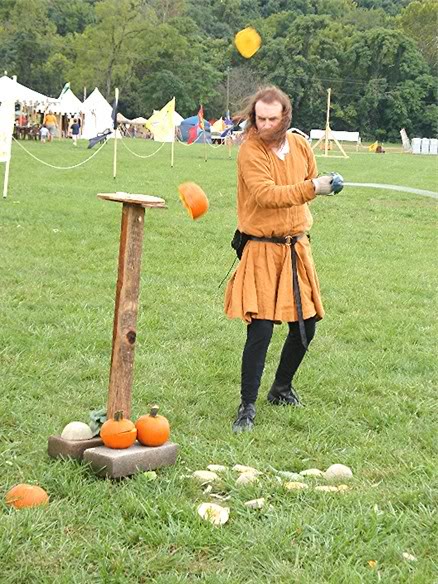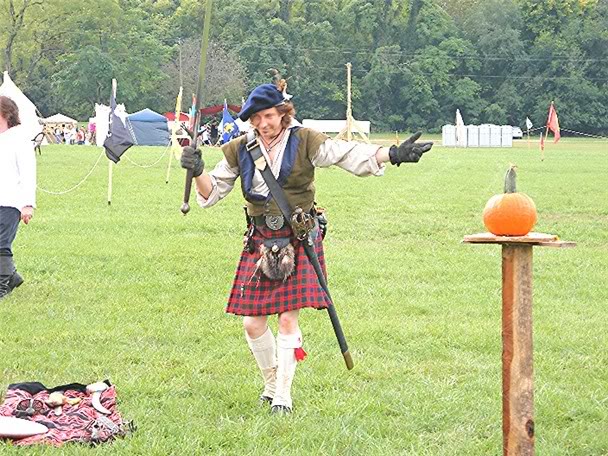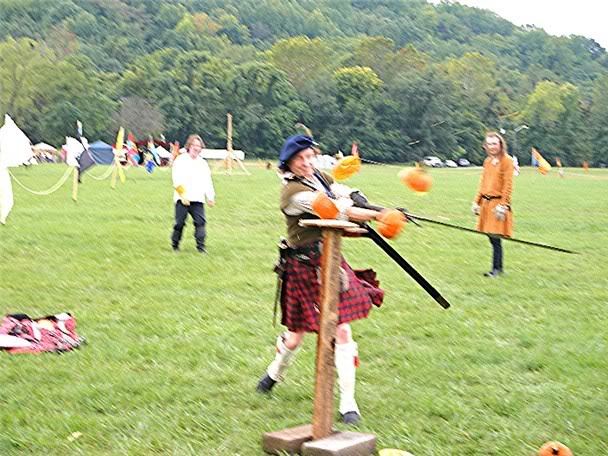| Author |
Message |
|
Klaus Gimm
Location: Germany Joined: 08 Aug 2008
Posts: 62
|
 Posted: Fri 10 Oct, 2008 11:29 am Post subject: Armour Class Scottish Claymore - Feels.. .awry Posted: Fri 10 Oct, 2008 11:29 am Post subject: Armour Class Scottish Claymore - Feels.. .awry |
 |
|
Hi folks.
Well the delivery from Armour Class arrived today at my door step after about 37 weeks. And its.. not what I had expected.
Okay the words "feels awry" are most likely not very helpfull in an internet forum post. So I try to be more specific.
Note: pictures are comming tomorrow. I have to borrow a friends digital camera.
The basic stats:
Weight: 2780 g (according to my kitchen scale)
Overall Length: 146,5 cm
Blade Length (measured from crossguard): 104,5 cm
Blade width (crossguard): 4,7 cm
Blade width (tip): 2,4
I had voted for the ornamented version and they look nice. a few light engravings near the langlet and a knottwork on the handle.
The polish on the crossguard looks a bit doubtfull on some places and not all too clean. But since I actually want to sparr with it with friends its not that much of a problem, stil lit seems a bit odd to miss it on quality control.
Regarding sparring - I picked up the blunted version and the tip as well as the edges are definetly save and the most elegantly blunted i have seen so far. Definetly safe.
Now the part that i am not happy with and that feels .. simply strange.
The blade wobbles. Okay i am aware that every blade has - and needs to be able to - the ability to bend and flex. But this goes so far to say i cant control the blade in a stage combat or at least would be definetly uneasy with it. The langelets on the side of the blade look a bit ajar and are not snugly on the blade as i would have expected. The blade itself is very thin and while still having a bit of a diamond section it is .. thin.
Steel is supposedly EN45 (according to google (SAE) equivalent is 9255). Does anyone have experience with that steel ?
All in all.. can someone post his or her experiences with swords of similar length. Does the blade wobble and vibrate that intensely when you swing it ?
Hoping for some input from you folks. As this is only my 2nd blade i lack the ability to compare. But right now my enthusiasm is -clearly- hindered.
Best regards
Klaus
|
|
   |
 |
Elling Polden

|
 Posted: Fri 10 Oct, 2008 11:55 am Post subject: Posted: Fri 10 Oct, 2008 11:55 am Post subject: |
 |
|
I've got an armour class single handed blade (modded, but though), and about half my club does as well. We have very good experiences with them.
They seem to be pretty much undestructable; I have had mine for more than a year, and have never had to file the blade for notches. (something that you have to do after every training with for instance a Hanweii)
So, the steel quality is definitely good enough.
"this [fight] looks curious, almost like a game. See, they are looking around them before they fall, to find a dry spot to fall on, or they are falling on their shields. Can you see blood on their cloths and weapons? No. This must be trickery."
-Reidar Sendeman, from King Sverre's Saga, 1201
|
|
    |
 |
|
Peter Lyon
Industry Professional
|
 Posted: Fri 10 Oct, 2008 12:08 pm Post subject: Posted: Fri 10 Oct, 2008 12:08 pm Post subject: |
 |
|
|
I used to use EN45A and still would if I could get it in New Zealand. It is a medium carbon steel (about .65%) with 1.7-2.1% silicon, which makes it very shock resistent - ideal for a sword than is going to have a hard life. That said, the other half of the equation is always about the heat treatment, and that is entirely in the hands of the sword maker.
|
|
  |
 |
Henrik Bjoern Boegh

Location: Agder, Norway Joined: 03 Mar 2004
Posts: 386
|
 Posted: Fri 10 Oct, 2008 12:10 pm Post subject: Posted: Fri 10 Oct, 2008 12:10 pm Post subject: |
 |
|
Yes, the AC blades are very tough. They have probably the best reputation in the UK as reenactment/sparring swords. I've got one myself and if sparring against a Hanwei it doesn't get more than scratches or tiny dents while the Hanwei suffers quite a few nicks.
I know many people in the UK who owns Armour Class swords and they all say the same thing about their toughness.
The blade on my basket hilted backsword wobbles a bit, bit not so much that it makes it harder to fight with it...
Cheers,
Henrik
Constant and true.
|
|
  |
 |
Chad Arnow
myArmoury Team


|
 Posted: Fri 10 Oct, 2008 12:50 pm Post subject: Posted: Fri 10 Oct, 2008 12:50 pm Post subject: |
 |
|
The big claymores weren't always stiff-bladed weapons. Several good reproductions I've seen have blades that sag under their own weight when held out straight. Consequently, the langets aren't tight to the blade as they get in the way.

ChadA
http://chadarnow.com/
|
|
    |
 |
|
GG Osborne
|
 Posted: Fri 10 Oct, 2008 3:53 pm Post subject: Armor Class blades Posted: Fri 10 Oct, 2008 3:53 pm Post subject: Armor Class blades |
 |
|
I have 5 of their basket hilts in my collection and you are right, the blades are very 'springy' but, at least for basket hilts, this seems to be about right in some cases. There are contemporary accounts of sword blades that could come close to being wrapped around the waist and return to true. Of all the blades I have seen commercially made, the Armor Class feels the best to me. I often think our standard of 'stiffness', etc. might be looking at the past through our 21st century lenses.
I wonder if the issue might be that our standard for what is "right' and "wrong" as regards blades is based on comparison with other commercial brands and what we are actually used to either in sparring or examination. Even the best of blades will ofter get brittle after a couple of hundred years sometimes and I would imagine that not too many of us save ElJay Ericson and Vince Evans (and a handful of others) have ever really held a two-hander from the period.
"Those who live by the sword...will usually die with a huge, unpaid credit card balance!"
|
|
  |
 |
William Goodwin

|
 Posted: Fri 10 Oct, 2008 4:58 pm Post subject: Posted: Fri 10 Oct, 2008 4:58 pm Post subject: |
 |
|
I absolutely adore my Armour Class mortuary....yes the blade does flex quite a bit,but just about right for my tastes'
you can see how much it flexes in a cut even after it's passed through the target. This was taken 2 weeks ago
at a demo we did at a local medieval faire......

Chad is right about the big claymores....a friend in the group has an old Krupp steel Del-Tin 2 hander and it is a beast,
a 3 ft razor blade really. It has a decent amount of flex to it as well.


(sorry for the fuzzy 2nd pic)
these baking pumpkins we were cutting were hard as nails, but the "big beastie" as we all call the Del-Tin had no troulbes
with taking out two.
The same chap with the claymore (Gary Hall) has a massive collection of antique Scottish basket-hilts and a couple can literally bend from tip to pommel with no problem.
back to the Armour Class...they will always be first rate in my book......
Cheers,
Bill
Roanoke Sword Guilde
roanokeswordguilde@live.com
"I was born for this" - Joan of Arc
|
|
   |
 |
Nathan Robinson
myArmoury Admin


|
 Posted: Fri 10 Oct, 2008 5:53 pm Post subject: Posted: Fri 10 Oct, 2008 5:53 pm Post subject: |
 |
|
Hi Klaus -
The blades are my least favorite part of the offerings from Armour Class. I have had the opportunity to handle about 10 pieces over the decade and another half dozen that were made prior to that. They were all great reenactment blades, but I have not handled one that I would consider "right" (whatever that means) for other purposes. They've all felt somewhat heavy and have odd dynamics with an unusual amount of flex to the blades. Having said that, it's these qualities that make them ideal and perhaps perfect for reenactment use, in my opinion.
.:. Visit my Collection Gallery :: View my Reading List :: View my Wish List :: See Pages I Like :: Find me on Facebook .:.
|
|
    |
 |
Jean Thibodeau

|
 Posted: Sat 11 Oct, 2008 4:41 am Post subject: Posted: Sat 11 Oct, 2008 4:41 am Post subject: |
 |
|
| Nathan Robinson wrote: | | They've all felt somewhat heavy and have odd dynamics with an unusual amount of flex to the blades. Having said that, it's these qualities that make them ideal and perhaps perfect for reenactment use, in my opinion. |
If they " bend / bounce / vibrate " and don't easily take a set, are hard enough to resist notching it might explain why they last so long being heavily used.  
The only thing I might object to is that mysterious " feels off " handling or vibrations making the sword hard to control in the bind.
Over flexibility might be a problem in a fighting sword that one wanted to be able to thrust effectively with ?
Oh, I have the A & A 15th century twohander and it does droop if held horizontally sideways: It is a fairly thick diamond shaped blade, but at 46" long any manageable blade this long is going to droop a bit unless made excessively thick and heavy in my opinion.
( Oh, I don't have personal handling experience of an Armour Class sword: So the above are just general comments ).
You can easily give up your freedom. You have to fight hard to get it back!
|
|
  |
 |
Chad Arnow
myArmoury Team


|
 Posted: Sat 11 Oct, 2008 6:26 am Post subject: Posted: Sat 11 Oct, 2008 6:26 am Post subject: |
 |
|
I owned a Del Tin Claymore and its blade sagged under its own weight when held out straight. Somewhere on this forum, there is a picture of Thomas MacDonald swinging the A&A Claymore heused to own. The blade was in mid-swing and noticeably flexed.
Here's the thread: http://www.myArmoury.com/talk/viewtopic.php?t=4781
It discusses gaps between langets and blade, and shows originals with gaps. It also has the pic of the A&A claymore in action:

So the langets not being flush with the blade is not uncommon on repros and originals and may be fairly normal/typical. At least 2 other well-known makers (Del Tin and A&A) have blades that can sag and flex, too.
I don't know exactly how much gap and flex yours exhibits, but it's possible (I think probable) the features yours has aren't unusual.

ChadA
http://chadarnow.com/
|
|
    |
 |
|
Klaus Gimm
Location: Germany Joined: 08 Aug 2008
Posts: 62
|
 Posted: Sat 11 Oct, 2008 10:43 am Post subject: Posted: Sat 11 Oct, 2008 10:43 am Post subject: |
 |
|
Hi Folks !
Thank you very much for your input on this its much apreciated. Hearing your insight helps me alot to understand the sword better.
Here are a few images. I hope the links do work.
Hmpf of course they dont. Waffleimage doesnt allow external links any longer.
Okay I am attaching some images I resized them and increased the compression rate. I hope they are still half way acceptable.
I have tried swinging the sword a bit today in the garden and gave it some smacks against Mr Dummy - my pile of old car wheels (without the inner metal frame). And speak about vibration. My hands are a ocean of blisters. Might be training though. However the bend is really intense and.. it rattels. I whole heartedly agree at this point to what was posted above. "They do not <feel> right." I will experiment some more tomorrow and add some more pictures.
I have an Arms & Armour claymore in the works (waiting for its delivery but as that has to go though german customs that will be a while) to compare it to this one.
Right now i honestly have to admitt its not what i had imagined. Maybe i didnt do enough research. I had hoped for a stiff sword with tight fittings. As the pommel looks screwed on i will see if i can dismantle it to take a look at the setup.
Thanks again to all for the feedback. Especially the link was an interesting read.
Yours sincerely,
Klaus
 Attachment: 121.85 KB Attachment: 121.85 KB
[ Download ]
 Attachment: 139.34 KB Attachment: 139.34 KB
[ Download ]
 Attachment: 113.32 KB Attachment: 113.32 KB
[ Download ]
 Attachment: 138.24 KB Attachment: 138.24 KB
[ Download ]
|
|
   |
 |
Nathan Robinson
myArmoury Admin


|
 Posted: Sat 11 Oct, 2008 12:43 pm Post subject: Posted: Sat 11 Oct, 2008 12:43 pm Post subject: |
 |
|
The langets don't bother me. They really aren't supposed to be touching hte blade. Swords that I've seen that have them touching end up making an odd "squeaking" noise when used.. There is almost always a space between langets on these types of swords and the blade itself and I imaigne this is how AC intended it to leave their shop.
.:. Visit my Collection Gallery :: View my Reading List :: View my Wish List :: See Pages I Like :: Find me on Facebook .:.
|
|
    |
 |
|
Justin King
Industry Professional
|
 Posted: Sat 11 Oct, 2008 4:07 pm Post subject: Posted: Sat 11 Oct, 2008 4:07 pm Post subject: |
 |
|
I read a quote some time ago from someone who researched and handled originals in museums and collections and he stated that many original claymores had blades that were around 3/16" or even thinner if I am remembering correctly, and a lenticular or worn hexagonal section. This combined with a relatively wide blade 40" or more in length, which is typical of originals, will result in a blade with a great deal of flex, regardless of steel type or heat treat.
I think that for a modern sparring weapon a very flexible blade is a matter of safety-blades for rapier combat are made flexible to allow for thrusting attacks to be landed without doing injury to the opponent. A rigid blade, even if blunted or having a button point, is dangerous as it allows the full force of a thrust to be transferred to the point of impact in a very short, sharp impulse which is likely to cause serious injury, instead of the more gradual impulse that is delivered by a more flexible blade, which usually only results in various degrees of bruising  . .
I would assume this to be true of other sparring weapons besides rapiers, that they are likely to be very felixible even if the weapons they are designed to mimic are not. In this case I think there is ample evidence that the originals probably had rather flexible blades but how well modern repros compare I cannot say.
|
|
  |
 |
Henrik Bjoern Boegh

Location: Agder, Norway Joined: 03 Mar 2004
Posts: 386
|
 Posted: Sun 12 Oct, 2008 4:41 am Post subject: Posted: Sun 12 Oct, 2008 4:41 am Post subject: |
 |
|
Remember that what you have there is a reenactment blunted blade. They don't capture the feel of the originals the same way a sharp or butterknife-edge/living-history edged sword does.
I've only got experience with the basket hilted broad- and backswords by AC and the the reenactment edged ones are excellently balanced and quite flexible. But the ones with a butterknife edge are much closer to how originals feel.
I've handled original mid 18th century basket hilts, a Vince Evans backsword, Mad Piper and AC and they are all light in the hand and very quick weapons.
I've not had the chanse to flex any originals (or the Vince Evans sword) but I do not doubt that the AC blades are close to the flex on originals.
Cheers,
Henrik
Constant and true.
|
|
  |
 |
Elling Polden

|
 Posted: Sun 12 Oct, 2008 7:03 am Post subject: Posted: Sun 12 Oct, 2008 7:03 am Post subject: |
 |
|
i have had several incidents during skirmish fencing where I've crashed/been run into by people, and seen my sword blade buckle something like 15 cm (6 in) and thinking "oooooh shit... THAT was hard". Most of the time, however, the flex made up for the impact.
A stiffer sword, however, might have caused injuries.
On a side note, some thrusting swords (XVII longswords, rapiers) are quite heavy because the baldes are made to NOT flex on impact. (try to thrust through a mail voider with a springy sword...)
"this [fight] looks curious, almost like a game. See, they are looking around them before they fall, to find a dry spot to fall on, or they are falling on their shields. Can you see blood on their cloths and weapons? No. This must be trickery."
-Reidar Sendeman, from King Sverre's Saga, 1201
|
|
    |
 |
|
|

